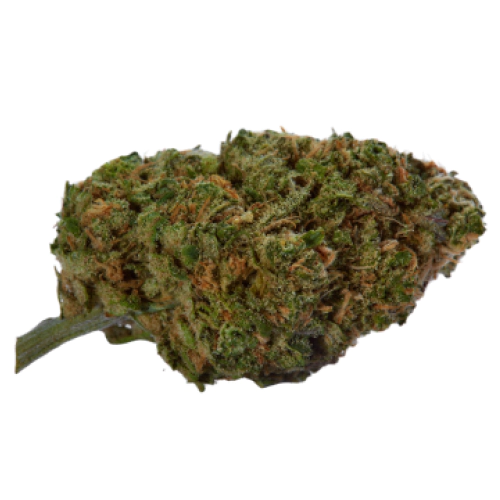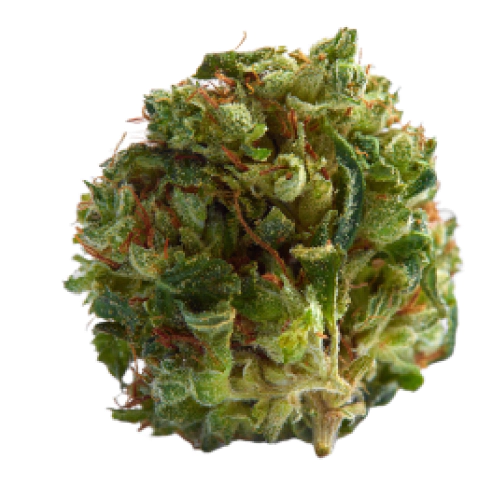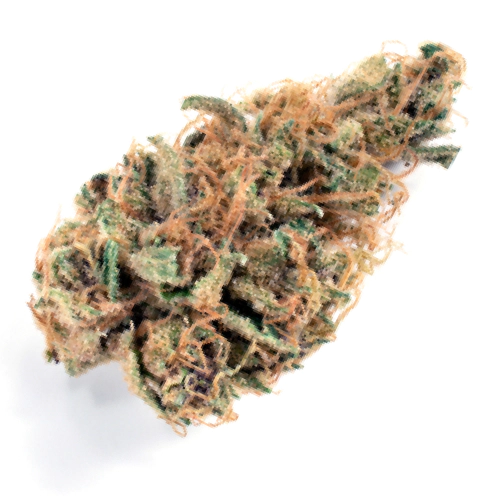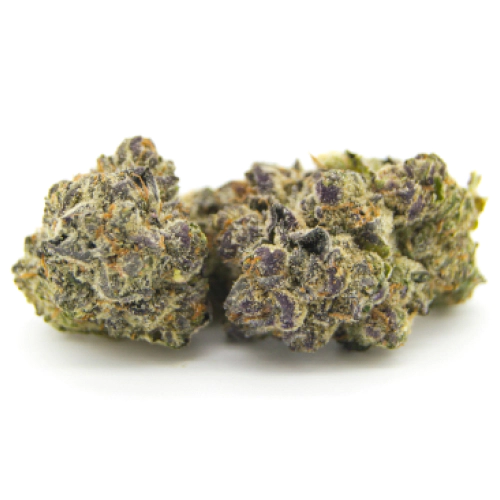THC 16.75 - 18.75%
CBD 0.57 - 0.78%
Effect Uplifted
Flavor Spicyherbal
15.5 - 17%
0.48 - 0.96%
0.5 - 1.23%
Mint, Woody
Relaxed
Thin Mint GSC, or Thin Mint Girl Scout Cookies, this cannabis strain takes its name from its natural sweet mint smell. At first sight, the Thin Mint strain is a mixture of fine green crystals hued with purple shots. It boasts a CBD level of less than 1% and a THC composition of between 14 and 17%, which is relatively easy and explains why the strain gives its users such out-of-body feelings on consumption both experienced and novice users love it.
Thin Mint GSC strain can trace their unique origin story back to San Francisco and to a charismatic family of cannabis growers only known as the Cookie Family. The Cookie Family is committed to growing plants using the most organic methods in order to better the world. The family created the Thin Mint strain by first crossing an F1 strain of the GSC variety with the Durban Poison strain. The resulting hybrid was then crossed with another hybrid, OG Kush.
The Thin Mint GSC strain is known for its sweet minty smell and cookie aroma, thanks to its concentration of the compounds humulene, alpha-pinene, myrcene, and caryophyllene. The combination of both can boost any appetite. Its aroma becomes chocolate-like when rolled up and smoked like a blunt, another reason to love it.
If you’ve always liked strains of a citrusy flavor, then you will love Thin Mints. And yet citrus is only one of its many flavors; the strain also has traces of peppery and hoppy influences. A quick inhalation will reveal that the peppery flavor is the strongest. On consumption, the mixture of flavors creates a lasting tingling feeling in the mouth.
Users of Thin Mint weed have unanimously highlighted its powerful effect on both the mind and the body at the same time.
One feels a strong jolting of the brain that triggers its creative faculties, even if one was tired before consumption. This is usually followed by an increased sense of focus. The same effect is usually experienced by the body, as one feels quickly energized in short busts. According to consumers, the effects include:
Thanks to its equal Sativa and Indica foundations (it is 50% Indica and 50% Sativa), the Thin Mint GSC weed strain is naturally equipped to provide a number of medicinal benefits. Users have reported positive results with Thin Mint cookies regarding such issues:
Despite its strict growing requirements and its medium yield, growers like the Thin Mint strain because they are popular among users who’ve tried it.
Growing your own Thin Mint Girl Scout Cookies strain is no major trouble. Growers are required to follow a few specific rules during the process, but everything else about the process is easy. You can start by getting seeds from a trusted seller. You can plant either indoors or outdoors. Give your plants the extra boost with some compost, and make sure the temperature outdoors is warm enough.
The plant flowers within 8 to 10 weeks of planting and can be harvested soon after. The plant itself is a low-yielder, so you can only expect medium yield whether you grow it outdoors or indoors. Each square meter planted can yield about 10-11 ounces of usable bud material when grown indoors, or 13 ounces when grown outdoors.
Alternatively, you can follow the growth strategy used by the Cookie Family. They use organic fertilizers and supplement indoor light with high-pressure sodium light bulbs over the growing plants. The Family also employs compost teas because the Thin Mint GSC strain, like all Girl Scout Cookie strains, requires higher nutrients to flourish.
| THC | Tetrahydrocannabinol, or THC, is a major cannabis chemical compound. It is a psychoactive element that stimulates dopamine release and induces euphoria or happiness. THC-rich strains may be helpful with such conditions as lack of appetite, chronic pains , etc. It is considered to be the primary active marijuana component. | 15.5 - 17% |
| CBD | Cannabidiol, or CBD, is a major compound in cannabis, which is non-psychoactive. It is also proved to counteract the side effects of the second major component THC. CBD is widely used for medicinal purposes in rubs, oils and so on. It is helpful in muscle pain cases, may treat arthritis and migraines. Even Greeks used it against pain, while Queen Victoria applied it to get rid of menstrual cramps. | 0.48 - 0.96% |
| CBC | Cannabichromene, or CBC, is a minor cannabinoid, meaning that its quantity in cannabis is quite little. Though it has the same origin as CBD and THC, it is different in functions. Without any psychoactive effects, it is an efficient cannabis compound in combating acne and depression. CBC produces analgesic, antibacterial and anti-inflammatory effects. | 0.14 - 0.57% |
| CBG | Cannabigerol, or CBG, is one of the minor cannabis compounds in adult plants. On the other hand, young ones contain a lot of this antibacterial and anti-inflammatory component. During the growth, CBG is converted into different cannabinoids, mostly THC and CBD. The compound itself increases appetite and decreases eye pressure. | 0.5 - 1.23% |
| CBN | Cannabinol, or CBN, is a trace element in cannabis that is considered to be mildly psychoactive. It appears from oxidation THC, exposed to light and heat. CBN is mostly contained in old cannabis and in traditional hashish. It is effective against insomnia, bacterial infections and appetite loss. | 0.29 - 0.17% |
| THCV | Tetrahydrocannabivarin, or THC-V, is a compound contained in cannabis in trace amounts. Even though it is close to THC molecularly, it is different in effects. This compound may be psychoactive only in large amounts. THC-V reduces blood sugar, controls appetite, stimulates bone growth, etc. African Sativa strains are the richest in THC-V. | 0.28 - 1.08% |
| Carene | Carene (also known as Delta-3 carene) is a terpene found in rosemary, lemons, pines, and cedars, offering citrusy and cypress aroma. Studies on mice showed that carene provides anti-inflammatory effects, as well as promotes bone health and chronic pain relief. | 0.17% |
| Pinene | Pinene is one of the most widespread terpenes in nature, found in pine trees, basil, nutmeg, parsley, and rosemary. Cannabis containing terpene (alpha-pinene or α-pinene) boasts a strong pine scent. Pinene is responsible for anti-inflammatory, pain-relieving, and anti-anxiety effects. | 0.04% |
| Myrcene | Myrcene (also known as β-myrcene) is one of the most common terpenes found in cannabis, representing more than 20% of the modern marijuana terpene profile. Myrcene has a distinct earthy, musky flavor, resembling cloves. It is responsible for calming and soothing effects of weed. Myrcene is also found in hops, thyme, mango, lemongrass, guava melon. | 0.1% |
| Ocimene | Ocimene (derived from the Ancient Greek word Ocimum meaning basil) is a terpene with sweet and herbaceous flavors, also boasting citrusy and woody undertones. Naturally, ocimene occurs in mint, parsley, orchids, hops, kumquats, mangoes, basil, bergamot, lavender, and pepper. Offers antifungal, anti-inflammatory, and antiviral properties. | 0.1% |
| Camphene | Camphene is terpene common for carrots, pepper, dill, fennel, nutmeg, thyme, as well as other fruits and vegetables. Camphene has a damp, pungent, herbal, minty aroma with pine undertones. In cannabis, mostly found in Indica strains. Camphene causes cooling sensations, having anti-inflammatory, antibiotic, antioxidant, analgesic, and antifungal effects. | 0.06% |
| Humulene | Humulene (also known as α-humulene) is one of the major terpenes found in cannabis, contributing to woody, earthy, spicy, herbaceous, and, mainly, floral aromas of cannabis. Used in modern medicine, humulene offers anti-inflammatory, antibacterial, and appetite suppressant effects, which have been well-researched by pharmaceutical companies. | 0.1% |
| Limonene | Limonene (also known as d-limonene) is the second most common terpene in nature and the third most common terpene in cannabis. It has a powerful citrus aroma and can be found in all citruses, including lemons, oranges, grapefruits, limes, juniper, etc. Limonene is known to elevate moods and provide anxiety, depression, and stress relief. | 0.11% |
| Linalool | Linalool (also known as beta linalool, linalyl alcohol, linaloyl oxide, and p-linalool) is one of the rarest terpenes found in cannabis, mostly in small quantities. Linalool is known for its spicy and lavender aroma, bringing relaxation and calming effects. It is also said to provide anti-inflammatory and analgesic properties that can be useful for athletes. | 0.05% |
| Caryophyllene | Caryophyllene (also known as beta or b caryophyllene) is a terpene found in many herbs and spices, such as black pepper, basil, rosemary, and oregano. Cannabis high in caryophyllene delivers a strong spicy, peppery aroma, resembling cinnamon and cloves. Caryophyllene offers potent anti-inflammatory and sedative effects. | 0.27% |
| Total terpenes content | 1.00% |
THC 16.75 - 18.75%
CBD 0.57 - 0.78%
Effect Uplifted
Flavor Spicyherbal

THC 20 - 21.5%
CBD 0.5 - 0.84%
Effect Giggly
Flavor Mint
THC 21.4 - 24.2%
CBD 0.34 - 0.55%
Effect Relaxed
Flavor Sweet
THC 16 - 16%
CBD 0.19 - 0.38%
Effect Euphoric
Flavor Spicyherbal
THC 20 - 20%
CBD 0.27 - 0.48%
Effect Relaxed
Flavor Skunk
THC 19.99 - 20.01%
CBD 0.7 - 0.94%
Effect Euphoric
Flavor Citrus
THC 19.33 - 21.67%
CBD 0.2 - 0.53%
Effect Happy
Flavor Sweet

THC 19.4 - 21.6%
CBD 0.32 - 0.56%
Effect Relaxed
Flavor Spicyherbal
THC 13.3 - 15.05%
CBD 0.41 - 0.6%
Effect Uplifted
Flavor Spicyherbal

THC 20.17 - 22.17%
CBD 1.86 - 2.34%
Effect Happy
Flavor Lemon
THC 20.8 - 23.6%
CBD 0.41 - 0.59%
Effect Relaxed
Flavor Pungent
THC 17.5 - 21.25%
CBD 0.75 - 0.95%
Effect Giggly
Flavor Berry

THC 20 - 22%
CBD 0.66 - 1.02%
Effect Uplifted
Flavor Citrus
THC 22.38 - 23.88%
CBD 0.29 - 0.74%
Effect Uplifted
Flavor Earthy
THC 17.67 - 19.33%
CBD 0.57 - 0.86%
Effect Happy
Flavor Sweet
THC 23 - 24.33%
CBD 0.49 - 0.84%
Effect Sleepy
Flavor Grapefruit
THC 20 - 22%
CBD 0.52 - 0.94%
Effect Uplifted
Flavor Lemon
THC 19.5 - 20%
CBD 0.72 - 1.3%
Effect Sleepy
Flavor Berry
THC 16 - 18%
CBD 0.02 - 1.11%
Effect Giggly
Flavor Woody
THC 20 - 25%
CBD 0.42 - 0.91%
Effect Concentrated
Flavor Ammonia

THC 16 - 19%
CBD 0.4 - 0.46%
Effect Tingly
Flavor Apple
Be the first and share your opinion
Write a Review